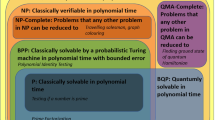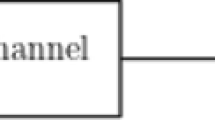Abstract
We consider the task of multiparty computation performed over networks in the presence of random noise. Given an n-party protocol that takes R rounds assuming noiseless communication, the goal is to find a coding scheme that takes \(R'\) rounds and computes the same function with high probability even when the communication is noisy, while maintaining a constant asymptotic rate, i.e., while keeping \(\liminf _{n,R\rightarrow \infty } R/R'\) positive. Rajagopalan and Schulman (STOC ’94) were the first to consider this question, and provided a coding scheme with rate \(O(1/\log (d+1))\), where d is the maximal degree in the network. While that scheme provides a constant rate coding for many practical situations, in the worst case, e.g., when the network is a complete graph, the rate is \(O(1/\log n)\), which tends to 0 as n tends to infinity. We revisit this question and provide an efficient coding scheme with a constant rate for the interesting case of fully connected networks. We furthermore extend the result and show that if a (d-regular) network has mixing time m, then there exists an efficient coding scheme with rate \(O(1/m^3\log m)\). This implies a constant rate coding scheme for any n-party protocol over a d-regular network with a constant mixing time, and in particular for random graphs with n vertices and degrees \(n^{\varOmega (1)}\).
Similar content being viewed by others
Notes
Each transmission in [43] is of a symbol taken from a small finite alphabet. Hence, each such symbol can be communicated with O(1) rounds of (bit) neighborhood connectivity.
The adjacency matrix of a graph \(G=(V,E)\) is defined by \(A(i, j) = 1\) if \((i, j) \in E\) and zero otherwise. In d-regular graphs, the normalized matrix is given by \(\hat{A}=\frac{1}{d} A\).
In relay we mean that if party i wants to send a bit to party j, it can send that bit to some party k who will later relay that bit to j. Thus, after sending the bit to k, the communication demand changes so that \(a_{i,j}=0\) and \(a_{k,j}\) increases by one.
References
Agrawal, S., Gelles, R., Sahai, A.: Adaptive protocols for interactive communication. In: 2016 IEEE International Symposium on Information Theory (ISIT), pp. 595–599 (2016). doi:10.1109/ISIT.2016.7541368
Alon, N.: The linear arboricity of graphs. Israel J. Math. 62(3), 311–325 (1988)
Alon, N.: A parallel algorithmic version of the local lemma. In: 32nd Annual Symposium on Foundations of Computer Science (San Juan, PR, 1991), pp. 586–593. IEEE Computer Society Press, Los Alamitos (1991). doi:10.1109/SFCS.1991.185423
Alon, N., Braverman, M., Efremenko, K., Gelles, R., Haeupler, B.: Reliable communication over highly connected noisy networks. In: Proceedings of the 2016 ACM Symposium on Principles of Distributed Computing, PODC ’16, pp. 165–173 (2016). doi:10.1145/2933057.2933085
Alon, N., Capalbo, M.: Finding disjoint paths in expanders deterministically and online. In: 48th Annual Symposium on Foundations of Computer Science, (2007), pp. 518–524. IEEE Computer Society Press, Los Alamitos (2007)
Alon, N., Spencer, J.H.: The Probabilistic Method, 3rd edn. Wiley-Interscience Series in Discrete Mathematics and Optimization. Wiley, Hoboken (2008). With an appendix on the life and work of Paul Erdős
Brakerski, Z., Kalai, Y.T.: Efficient interactive coding against adversarial noise. In: Proceedings of the IEEE Symposium on Foundations of Computer Science, pp. 160–166 (2012)
Brakerski, Z., Kalai, Y.T., Naor, M.: Fast interactive coding against adversarial noise. J. ACM 61(6), 35:1–35:30 (2014). doi:10.1145/2661628
Brakerski, Z., Naor, M.: Fast algorithms for interactive coding. In: Proceedings of the 24th Annual ACM-SIAM Symposium on Discrete Algorithms, SODA ’13, pp. 443–456 (2013)
Braverman, M., Efremenko, K.: List and unique coding for interactive communication in the presence of adversarial noise. In: Proceedings of the IEEE Symposium on Foundations of Computer Science, FOCS ’14, pp. 236–245 (2014)
Braverman, M., Efremenko, K., Gelles, R., Haeupler, B.: Constant-rate coding for multiparty interactive communication is impossible. In: Proceedings of the 48th Annual ACM SIGACT Symposium on Theory of Computing, STOC 2016, pp. 999–1010 (2016)
Braverman, M., Rao, A.: Towards coding for maximum errors in interactive communication. In: Proceedings of the 43rd Annual ACM Symposium on Theory of Computing, STOC ’11, pp. 159–166. ACM, New York (2011). doi:10.1145/1993636.1993659
Braverman, M., Rao, A.: Toward coding for maximum errors in interactive communication. IEEE Trans. Inf. Theory 60(11), 7248–7255 (2014). doi:10.1109/TIT.2014.2353994
Broder, A., Frieze, A., Upfal, E.: Existence and construction of edge-disjoint paths on expander graphs. SIAM J. Comput. 23(5), 976–989 (1994). doi:10.1137/S0097539792232021
Broder, A.Z., Frieze, A.M., Suen, S., Upfal, E.: Optimal construction of edge-disjoint paths in random graphs. SIAM J. Comput. 28(2), 541–573 (1998). doi:10.1137/S0097539795290805
Chandrasekaran, K., Goyal, N., Haeupler, B.: Deterministic algorithms for the Lovász local lemma. SIAM J. Comput. 42(6), 2132–2155 (2013)
Chung, K.M., Pass, R., Telang, S.: Knowledge-preserving interactive coding. In: Proceedings of the 54th Annual IEEE Symposium on Foundations of Computer Science (FOCS), pp. 449–458 (2013)
Cook, N.A., Goldstein, L., Johnson, T.: Size biased couplings and the spectral gap for random regular graphs. arXiv preprint arXiv:1510.06013 (2015)
Cover, T.M., Thomas, J.A.: Elements of Information Theory, 2nd edn. Wiley, New York (2006)
Dolev, D., Lenzen, C., Peled, S.: Tri, Tri again: Finding triangles and small subgraphs in a distributed setting. In: Aguilera, M., (ed.) Distributed Computing, Lecture Notes in Computer Science, vol. 7611, pp. 195–209. Springer, Berlin Heidelberg (2012). doi:10.1007/978-3-642-33651-5_14
Efremenko, K., Gelles, R., Haeupler, B.: Maximal noise in interactive communication over erasure channels and channels with feedback. IEEE Trans. Inf. Theory 62(8), 4575–4588 (2016). doi:10.1109/TIT.2016.2582176
Erdős, P., Lovász, L.: Problems and results on 3-chromatic hypergraphs and some related questions. Infinite Finite sets 10, 609–627 (1975)
Franklin, M., Gelles, R., Ostrovsky, R., Schulman, L.J.: Optimal coding for streaming authentication and interactive communication. In: Advances in Cryptology–CRYPTO 2013, LNCS, vol. 8043, pp. 258–276. Springer (2013)
Franklin, M., Gelles, R., Ostrovsky, R., Schulman, L.J.: Optimal coding for streaming authentication and interactive communication. IEEE Trans. Inf. Theory 61(1), 133–145 (2015). doi:10.1109/TIT.2014.2367094
Gallager, R.: Finding parity in a simple broadcast network. IEEE Trans. Inf. Theory 34(2), 176–180 (1988). doi:10.1109/18.2626
Gelles, R.: Coding for interactive communication: a survey (2015). http://www.eng.biu.ac.il/~gellesr/survey.pdf
Gelles, R., Haeupler, B.: Capacity of interactive communication over erasure channels and channels with feedback. In: Proceedings of the Twenty-Sixth Annual ACM-SIAM Symposium on Discrete Algorithms, SODA ’15, pp. 1296–1311 (2015)
Gelles, R., Moitra, A., Sahai, A.: Efficient and explicit coding for interactive communication. In: Proceeding of the IEEE Symposium on Foundations of Computer Science, FOCS ’11, pp. 768–777 (2011)
Gelles, R., Moitra, A., Sahai, A.: Efficient coding for interactive communication. IEEE Trans. Inf. Theory 60(3), 1899–1913 (2014). doi:10.1109/TIT.2013.2294186
Gelles, R., Sahai, A., Wadia, A.: Private interactive communication across an adversarial channel. In: Proceedings of the 5th Conference on Innovations in Theoretical Computer Science, ITCS ’14, pp. 135–144. ACM (2014). doi:10.1145/2554797.2554812
Ghaffari, M., Haeupler, B.: Optimal Error Rates for interactive coding II: efficiency and list decoding. In: Proceedings of the IEEE Symposium on Foundations of Computer Science, FOCS ’14, pp. 394–403 (2014)
Ghaffari, M., Haeupler, B., Sudan, M.: Optimal error rates for interactive coding I: adaptivity and other settings. In: Proceedings of the 46th Annual ACM Symposium on Theory of Computing, STOC ’14, pp. 794–803. ACM, New York, NY, USA (2014). doi:10.1145/2591796.2591872
Goyal, N., Kindler, G., Saks, M.: Lower bounds for the noisy broadcast problem. SIAM J. Comput. 37(6), 1806–1841 (2008). doi:10.1137/060654864
Guruswami, V., Indyk, P.: Linear-time encodable/decodable codes with near-optimal rate. IEEE Trans. Inf. Theory 51(10), 3393–3400 (2005). doi:10.1109/TIT.2005.855587
Haeupler, B.: Interactive channel capacity revisited. In: Proceedings of the IEEE Symposium on Foundations of Computer Science, FOCS ’14, pp. 226–235 (2014)
Hoza, W.M., Schulman, L.J.: The adversarial noise threshold for distributed protocols. In: Proceedings of the Twenty-Seventh Annual ACM-SIAM Symposium on Discrete Algorithms, pp. 240–258 (2016). doi:10.1137/1.9781611974331.ch18
Jain, A., Kalai, Y.T., Lewko, A.: Interactive coding for multiparty protocols. In: Proceedings of the 6th Conference on Innovations in Theoretical Computer Science, ITCS ’15, pp. 1–10 (2015)
Kol, G., Raz, R.: Interactive channel capacity. In: STOC ’13: Proceedings of the 45th annual ACM symposium on Symposium on theory of computing, pp. 715–724. ACM, New York, NY, USA (2013). doi:10.1145/2488608.2488699
Lenzen, C.: Optimal deterministic routing and sorting on the congested clique. In: Proceedings of the 2013 ACM Symposium on Principles of Distributed Computing, PODC ’13, pp. 42–50. ACM, New York, NY, USA (2013). doi:10.1145/2484239.2501983
Moser, R.A., Tardos, G.: A constructive proof of the general Lovász local lemma. J. ACM 57(2), 11:1–11:15 (2010). doi:10.1145/1667053.1667060
Pankratov, D.: On the power of feedback in interactive channels. [Online:] http://people.cs.uchicago.edu/~pankratov/papers/feedback.pdf (2013)
Rajagopalan, S.: A coding theorem for distributed computation. Ph.D. thesis, University of California at Berkeley, Berkeley, CA, USA (1994). UMI Order No. GAX95-29464
Rajagopalan, S., Schulman, L.: A coding theorem for distributed computation. In: STOC ’94: Proceedings of the twenty-sixth annual ACM symposium on Theory of computing, pp. 790–799. ACM, New York, NY, USA (1994). doi:10.1145/195058.195462
Schulman, L.J.: Communication on noisy channels: a coding theorem for computation. In: Annual IEEE Symposium on Foundations of Computer Science, pp. 724–733 (1992). doi:10.1109/SFCS.1992.267778
Schulman, L.J.: Deterministic coding for interactive communication. In: STOC ’93: Proceedings of the Twenty-Fifth Annual ACM Symposium on Theory of Computing, pp. 747–756. ACM, New York (1993). doi:10.1145/167088.167279
Schulman, L.J.: Coding for interactive communication. IEEE Trans. Inf. Theory 42(6), 1745–1756 (1996)
Shannon, C.E.: A mathematical theory of communication. ACM SIGMOBILE Mobile Computing and Communications Review 5(1), 3–55 (2001). [Originally appeared in Bell System Tech. J. 27, 379–423, 623–656, 1948]
Spielman, D.A.: Linear-time encodable and decodable error-correcting codes. In: Proceedings of the Twenty-Seventh Annual ACM Symposium on Theory of Computing, STOC ’95, pp. 388–397. ACM, New York (1995). doi:10.1145/225058.225165
Tikhomirov, K., Youssef, P.: The spectral gap of dense random regular graphs. arXiv preprint arXiv:1610.01765 (2016)
Author information
Authors and Affiliations
Corresponding author
Additional information
A preliminary extended abstract of this work [4], appeared in the Proceedings of the 2016 ACM Symposium on Principles of Distributed Computing (PODC ’16).
Noga Alon: Research supported in part by a BSF Grant, an ISF Grant, a GIF Grant and the Israeli I-Core program. Mark Braverman: Research supported in part by NSF Awards, DMS-1128155, CCF-1525342, and CCF-1149888, a Packard Fellowship in Science and Engineering, and the Simons Collaboration on Algorithms and Geometry. Any opinions, findings and conclusions or recommendations expressed in this material are those of the author(s) and do not necessarily reflect the views of the National Science Foundation. Klim Efremenko: Research supported in part by: European Communitys Seventh Framework Programme (FP7/2007-2013) under Grant agreement number 257575. Bernhard Haeupler: Research supported in part by NSF Grants CCF-1527110 and CCF-1618280.
Rights and permissions
About this article
Cite this article
Alon, N., Braverman, M., Efremenko, K. et al. Reliable communication over highly connected noisy networks. Distrib. Comput. 32, 505–515 (2019). https://doi.org/10.1007/s00446-017-0303-5
Received:
Accepted:
Published:
Issue Date:
DOI: https://doi.org/10.1007/s00446-017-0303-5




